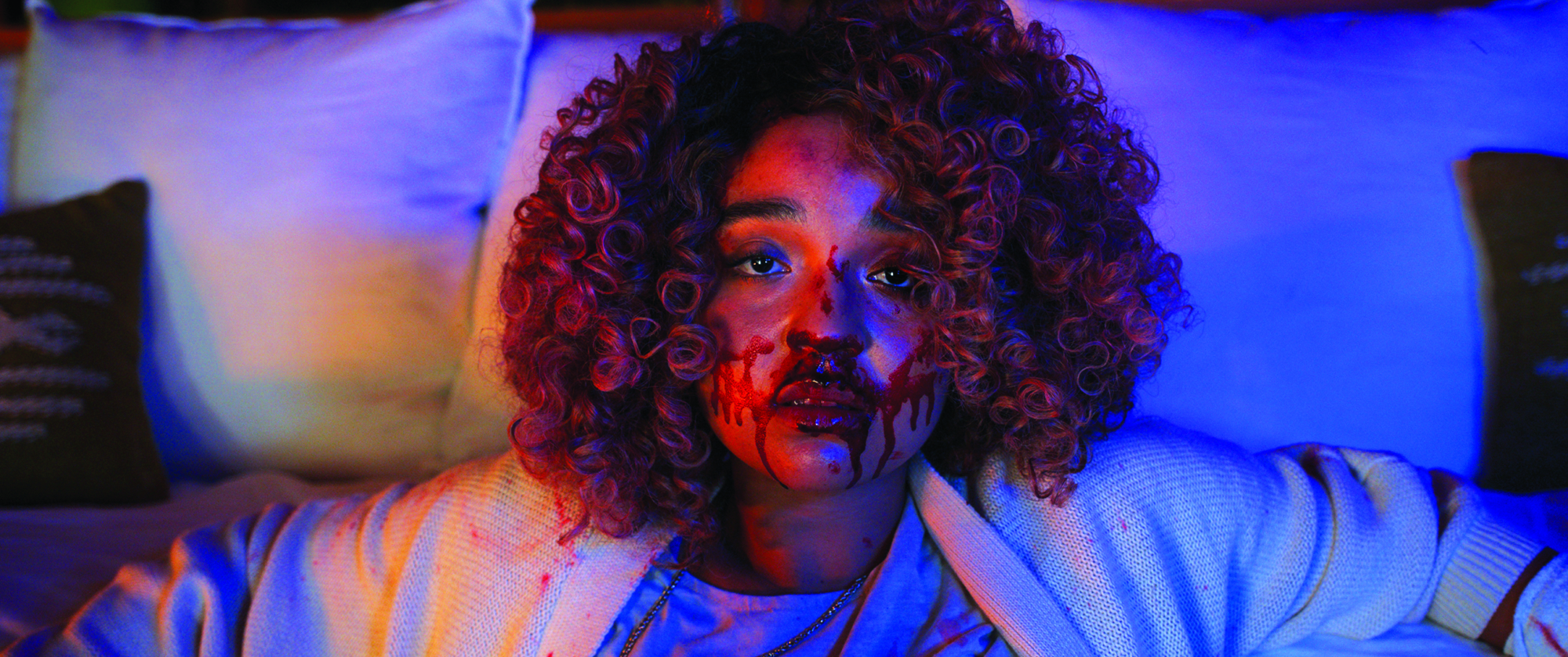In 2017, young Australian couple Hannah Barlow and Kane Senes co-shot their collaborative feature debut[1]Senes had previously directed a feature on his own, the Texas-shot western Echoes of War (2015). – the largely improvised road movie For Now – in California, where they were then living in the hope of making a go of it in Hollywood. Inspired by the movies of American indie-film pioneer John Cassavetes[2]See Jeremy Carr, ‘Cassavetes, John’, Senses of Cinema, no. 79, July 2016, available at <https://www.sensesofcinema.com/2016/great-directors/john-cassavetes/>, accessed 23 June 2022. as well as those of the noughties mumblecore movement spearheaded by the likes of Lynn Shelton, Joe Swanberg and the Duplass brothers,[3]See Mike Bedard, ‘What Is Mumblecore? An American DIY Film Movement’, StudioBinder blog, 19 April 2020, <https://www.studiobinder.com/blog/what-is-mumblecore-film-movement/>, accessed 23 June 2022. Barlow and Senes settled on a make-do and mend solution: ‘These filmmakers encouraged us that, instead of waiting for the industry to discover you, you go and do it yourself and make a film for under $100,000,’ Barlow recalls.
Reviewing For Now in FilmInk, critic Travis Johnson noted of the low-budget production’s particular style that ‘it’s worth remembering that these [filmmakers and actors] are members of a generation that have grown up in the panopticon of social media – performative behaviour arises naturally out of that environment’.[4]Travis Johnson, ‘For Now’, FilmInk, 3 May 2017, <https://www.filmink.com.au/reviews/for-now/>, accessed 23 June 2022. So it’s appropriate that the occasionally ugly and illusory aspects of social media’s performative realm are the explicitly satirical focus of Barlow and Senes’ follow-up offering, the Australian Capital Territory–set horror-comedy Sissy (2022). The film stars The Bold Type lead Aisha Dee as a social media influencer who, via her ‘Sincerely Cecilia’ Instagram account and YouTube channel, projects an air of serene calm while spouting textbook affirmations and spruiking products (including the amusingly named ‘Elon Mask’). But it soon becomes apparent that Cecilia isn’t quite as calm as her sponsored content–laden vlog would have everyone believe.
‘It started with the fear and the toxicity of social media,’ says Senes of the creation of antihero Cecilia’s complicated wellness-influencer identity, with the directors also dipping into scandals such as the scam infamously perpetrated by ‘alternative’ health guru and pretend cancer survivor Belle Gibson.[5]See Beau Donelly & Nick Toscano, ‘Refund Calls over “Cancer Survivor” Belle Gibson’s Book and App Sales’, The Age, 11 March 2015, <https://www.theage.com.au/technology/refund-calls-over-cancer-survivor-belle-gibsons-book-and-app-sales-20150311-141by8.html>, accessed 24 June 2022. Senes is particularly concerned about the impact on young minds of online bullying, and the impossible standards that such platforms present as reality. ‘I’ve got five nieces and a nephew, and they all follow influencers,’ he adds, noting how disturbing he finds this trend.
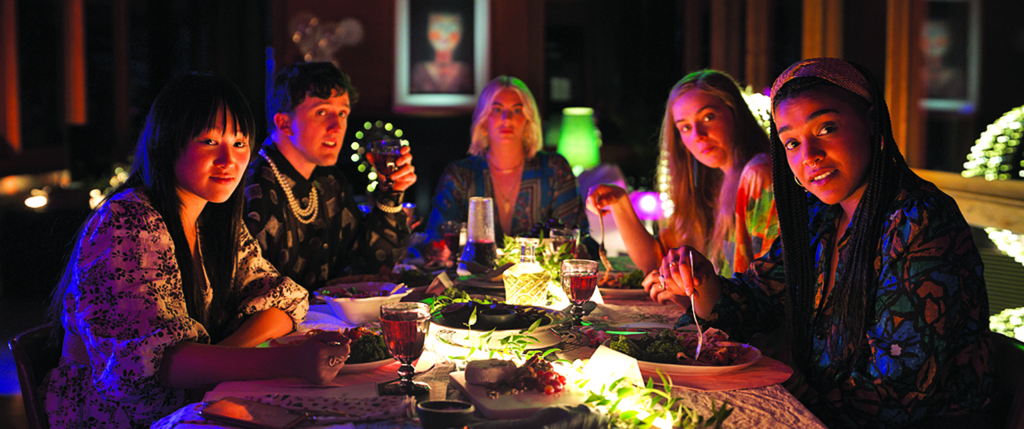
The idea of drawing on heightened ‘reality’ helped their writing process, with the Sissy characters stopping what they’re doing to tune in to their favourite reality TV series, the saucily fictional show-within-the-film Paradise Lust. ‘It’s an extension of the same thing, right?’ Senes asks. ‘What you’re watching is very manicured, and the producers tailor it to drive certain narratives.’ Barlow agrees with this characterisation:
I was watching a lot of The Bachelor and Love Island at the time [of writing], and I just found it fascinating how gen Z and millennials can be so disconnected, because we’re engaging so much online, which is causing real mental health issues and also toxic evolutions in our brains. But then we’re also addicted to these reality shows where people are tearing each other apart.
Worrying as this cultural trend may be, Senes and Barlow could see the potential in blowing up the pitfalls of the platforms into an outsized and schlocky horror movie, and ran wild with the concept. When Cecilia bumps into former best friend Emma (played by Barlow herself as an adult, and by Camille Cumpston in VHS-style flashbacks to their primary school days), an old psychological wound is torn wide open. During the awkward reunion, Emma invites a clearly uncomfortable Cecilia to her hens’ party weekend without mentioning to her that her former school bully, Alex (Emily De Margheriti), will also be present. It’s safe to say that, when Cecilia shows up at the party held in a swish Airbnb one hour’s drive from Canberra, Alex is not best pleased to see her.
You have to wonder why, in a film with no clear delineation between goodies and baddies, Emma couldn’t have predicted this reaction. As Barlow sees it, Emma may appear outwardly sweet and a peacemaker, but her failure to run the invitation by Alex is suspect. ‘Alex is coming to the table honestly, as is Cecilia, but Emma is kind of duplicitous,’ she says. ‘And her inability to be accountable creates horror for the entire group.’
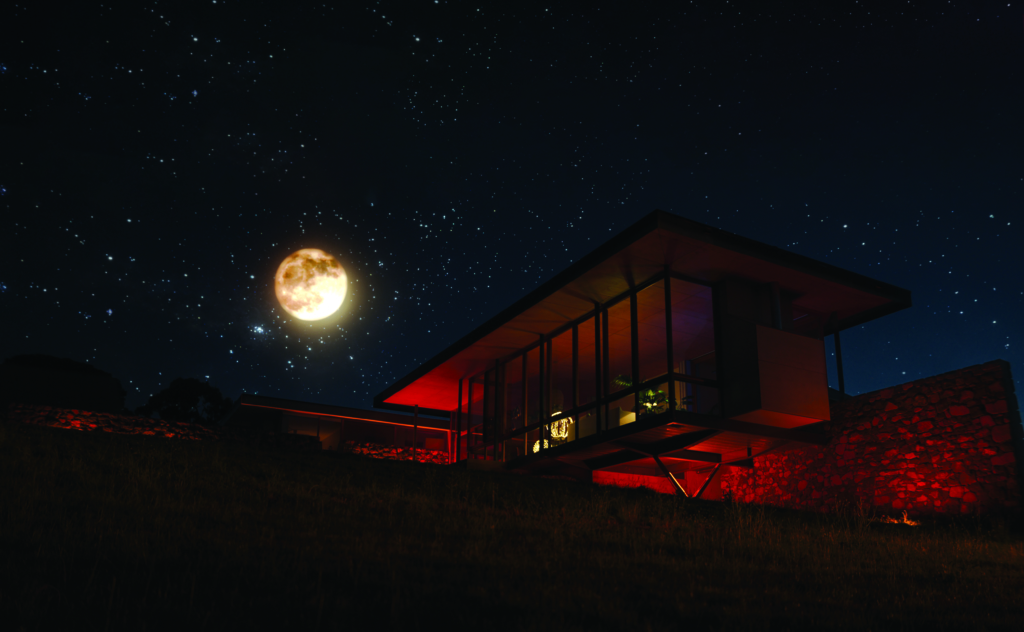
Backing in the Final Girl
Opening the Pandora’s box of Cecilia’s childhood trauma helps get the audience onside with the influencer from the off. But it’s not straightforward. Sissy gradually teases out, in flashback, an inappropriately chuckle-inducing violent incident that goes down between the young Cecilia (Amelia Lule) and Alex (April Blasdall), in which the latter repeatedly taunts the former with the slur ‘sissy’. This insult cuts Cecilia deeply, and she promptly repays the favour in a more literal fashion.
Flash forward to their impromptu weekend away and Alex, now bearing the scars of a long-festering grudge, is not willing to let the incident slide. Recognising an opportunity for revenge, she is encouraged to go ever further in her abusive crusade against Cecilia by her best friend and fellow party attendee Jamie (played by the delightful Daniel Monks, cast against type as a real mean queen). Barlow recalls presenting an early draft of the screenplay to Monks, who is hemiplegic and uses crutches,[6]See Stephen A Russell, ‘The Queer, Disabled Filmmaker Exploring His Story on the Big Screen’, SBS Pride, updated 3 December 2020, <https://www.sbs.com.au/topics/pride/fast-lane/article/2017/03/20/queer-disabled-filmmaker-exploring-his-story-big-screen>, accessed 24 June 2022. and raising concerns over the brutality of the film’s violent turn as it relates to his character:
I’ve known Daniel for over a decade, and he’s a good friend. We took the script to him asking questions about how far we [could] push it, and he was like, ‘Guys, you need to be way more offensive than this.’
Senes and Barlow took him at his word, and the film accordingly goes all out when the time comes for Jamie’s demise.
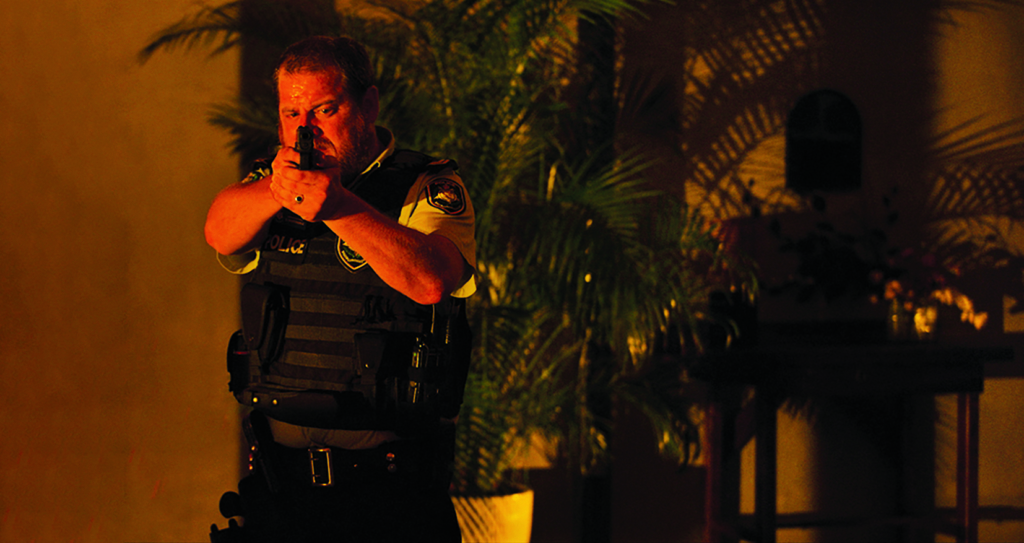
Though the character of Cecilia shares DNA with the likes of Gibson and reality TV stars–turned–pop culture corporations like the Kardashians in her worst excesses, Sissy asks the audience to root for her as they would a more traditional Final Girl figure, epitomised by Laurie (Jamie Lee Curtis) in the original Halloween (John Carpenter, 1978) and most of its sequels and reboots. Even so, Barlow and Senes also have fun grafting elements of Laurie’s murderous stalker Michael Myers (Tony Moran) onto their appearance-obsessed protagonist, who values the sanctity of her Instagram stream over that of human life.
‘Depending on who you ask, [viewers] might stand up for someone else,’ Senes says, reflecting on the film’s reception since it premiered at the South by Southwest Film Festival in March 2022 before making its way to Australia for June’s Sydney Film Festival. ‘But we’ve been really surprised – in a good way – that most people […] ride or die with her all the way through.’
The challenge, as writers, was to see just how far they could push that loyalty. Senes says that he and Barlow were impressed, while penning the screenplay for Sissy, by the way writer/director Todd Phillips blurred those moral lines in his comic-book origin story Joker (2019). ‘We were blown away by how much you empathise with this character because he’s on the outskirts of society,’ he says of Joaquin Phoenix’s proto–Clown Prince. ‘We relate to and can always root for an underdog.’
Making a mess
While no animals were harmed in the making of the movie, Sissy’s first not-for-the-squeamish scene is set early on, when one half of the Australian heraldic emblem comes to an unfortunate end – a sequence that also delivers the film’s greatest callback in its totally unhinged final act.
Barlow and Senes knew they had to get the best in the business to bring about the carnage of the outré killing spree that follows. They were drawn to the remarkable work of seasoned prosthetics designer Larry Van Duynhoven, having admired his work on Natalie Erika James’ creeper Relic (2020).[7]See Josh Nelson, ‘House of Horrors: Ageing and Loss in Natalie Erika James’ Relic’, Metro, no. 206, 2020, available at <https://metromagazine.com.au/house-of-horrors/>, accessed 24 June 2022. ‘We saw that scene at the end when [Edna (Robyn Nevin)] peels off her skin and we were like, “We need to work with this guy,”’ Senes says.
Ever in demand, the endlessly talented Van Duynhoven has also helped realise some of the most shocking moments in films like Lake Mungo (Joel Anderson, 2008), The Loved Ones (Sean Byrne, 2009) and The Nightingale (Jennifer Kent, 2018), as well as TV shows including Glitch, Firebite and The Tourist. He certainly rose to the challenge of meeting the directors’ sickest requests for Sissy, Senes notes.
He and his team would spend two months painstakingly making a fake head from a mould of an actor, weaving every strand of hair, just so we could crush it in one take.
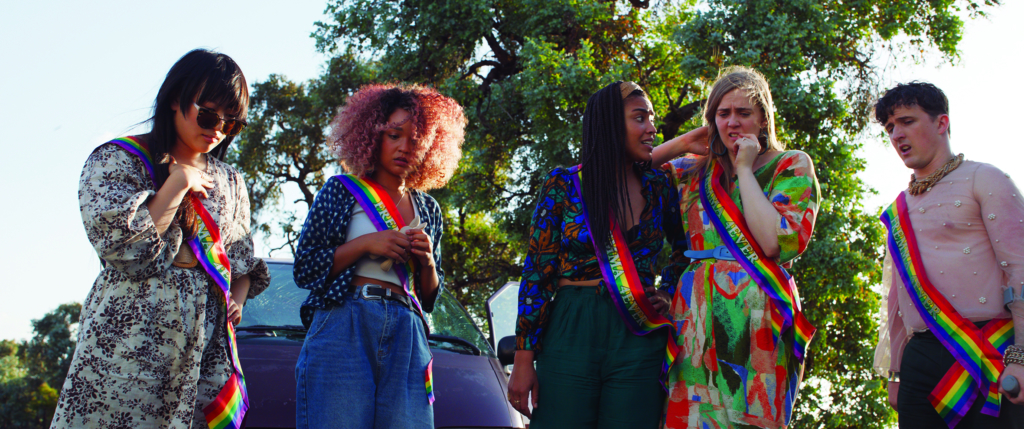
The filmmakers drew inspiration from the works of the great gore masters of the 1970s and 1980s: Sam Raimi’s Evil Dead movies; the body horror of David Cronenberg (especially for a dream sequence involving Alex); the neon-lit nightmares of giallo king Dario Argento; and the psychokinetic teenage trauma of Brian De Palma’s Carrie (1976). ‘That era celebrated practical effects with prosthetics,’ Senes says.
The kill scenes had to go to a place of shocking violence, to counteract the comedy. It couldn’t feel like a comedy that had some violence. That tonal clash had to exist.
Barlow also flags the off-kilter comedy of Robert Zemeckis’ ferociously funny Death Becomes Her (1992) as a touchstone. ‘While the audience is laughing, they’re also cringing and feeling a bit ashamed,’ she says of similarities in tone between that film and the outrageous way Sissy splashes buckets of blood and gore and entrails galore while playing for snappy laughs.
Not all of their reference points are as easily recognisable, or even hailing from the horror genre, however. Barlow and Senes say that the landmark Australian comedy Muriel’s Wedding (PJ Hogan, 1994) also helped inform Sissy’s tone. ‘It’s not a horror film, but that was one of our biggest influences:’ Senes explains. ‘What if you took Muriel (Toni Collette)—’ Here, Barlow cuts in: ‘—And she just started murdering everybody at the halfway point?’ As Senes sees it, the slasher-movie template is primed for personal spins. ‘Even though [all of those films] follow a similar formula, they all reflect the era in which they were made,’ he says.
‘We had some pretty fun discussions, especially about giallo films, with the original Suspiria a massive reference for the lighting and the colour. We wanted it to be a rainbow-nightmare, pop-infused, kaleidoscopic fracturing.’
– Hannah Barlow
Director of photography Steve Arnold helped them get the look of Sissy right. ‘We talked a lot about Brian De Palma’s use of zoom lenses, and [Steve] had a real appreciation for horror,’ Senes says. ‘That’s also part of the practicality of shooting quickly.’ For her part, Barlow relished Arnold’s enthusiasm for the gig: ‘We had some pretty fun discussions, especially about giallo films, with the original Suspiria [Argento, 1977] a massive reference for the lighting and the colour,’ she recounts. ‘We wanted it to be a rainbow-nightmare, pop-infused, kaleidoscopic fracturing, and he just ran […] with it.’
They had great backup in production designer Michael Price, art director Courtney Westbrook and editor Margi Hoy, who all went wild with the film’s look. Hoy hit on the idea of using Instagram filters in the final skull-crushing stretch of Sissy, which Barlow says was inspired: ‘At some point [Margi] just said, “This house had become young Cecilia’s time capsule, so let’s go all Disney psycho-pop with it.”’
And why not? If Barlow and Senes ever doubted they would get their Hollywood ending while doing it tough in Los Angeles all those years ago, the audience embrace of Sissy would seem to suggest that happily ever after awaits – and whether social media or reality TV is included is up to them.
Endnotes
| 1 | Senes had previously directed a feature on his own, the Texas-shot western Echoes of War (2015). |
|---|---|
| 2 | See Jeremy Carr, ‘Cassavetes, John’, Senses of Cinema, no. 79, July 2016, available at <https://www.sensesofcinema.com/2016/great-directors/john-cassavetes/>, accessed 23 June 2022. |
| 3 | See Mike Bedard, ‘What Is Mumblecore? An American DIY Film Movement’, StudioBinder blog, 19 April 2020, <https://www.studiobinder.com/blog/what-is-mumblecore-film-movement/>, accessed 23 June 2022. |
| 4 | Travis Johnson, ‘For Now’, FilmInk, 3 May 2017, <https://www.filmink.com.au/reviews/for-now/>, accessed 23 June 2022. |
| 5 | See Beau Donelly & Nick Toscano, ‘Refund Calls over “Cancer Survivor” Belle Gibson’s Book and App Sales’, The Age, 11 March 2015, <https://www.theage.com.au/technology/refund-calls-over-cancer-survivor-belle-gibsons-book-and-app-sales-20150311-141by8.html>, accessed 24 June 2022. |
| 6 | See Stephen A Russell, ‘The Queer, Disabled Filmmaker Exploring His Story on the Big Screen’, SBS Pride, updated 3 December 2020, <https://www.sbs.com.au/topics/pride/fast-lane/article/2017/03/20/queer-disabled-filmmaker-exploring-his-story-big-screen>, accessed 24 June 2022. |
| 7 | See Josh Nelson, ‘House of Horrors: Ageing and Loss in Natalie Erika James’ Relic’, Metro, no. 206, 2020, available at <https://metromagazine.com.au/house-of-horrors/>, accessed 24 June 2022. |
